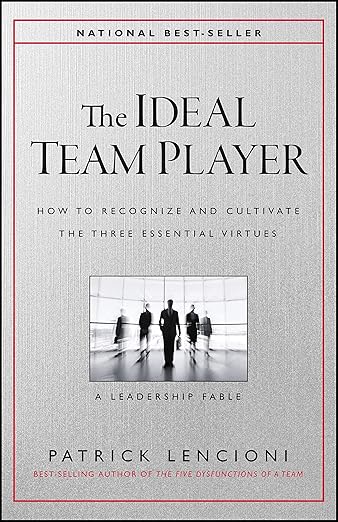“The Ideal Team Player” by Patrick Lencioni
Who is it for? For leaders, managers, and business owners building high-performing, values-driven teams.
The Ideal Team Player by Patrick Lencioni is a compelling and highly practical guide to identifying, hiring, and developing team members who embody the core behaviours needed for a cohesive and successful team. Told through a fable – a style Lencioni is known for – the book brings to life the challenges of team building within the context of a fictional company facing a leadership transition and cultural shift.
Lencioni identifies three essential virtues that define the ideal team player: humble, hungry, and smart (with “smart” referring to emotional intelligence and interpersonal awareness, not intellectual capability). These characteristics form the foundation of his model, which is designed to help leaders shape team culture, make better hiring decisions, and address underperformance constructively.
The story format makes the concepts accessible and relatable, particularly for those who prefer learning through narrative rather than dense theory. Lencioni follows up the fable with a practical framework that includes diagnostic tools, interview tips, and real-world applications for embedding these principles in your team or business.
The main challenge lies not in understanding the model but in applying it consistently. In the real world, few team members neatly tick all three boxes. Leaders will need to exercise judgment and patience when coaching people to develop the traits they lack – particularly humility, which can be the hardest to teach. There’s also the risk of oversimplification, as people and team dynamics are rarely black and white.
Additionally, while the book offers a clear and structured approach, it assumes that organisations already have the appetite and capacity to reshape their culture around these values. For businesses with deeply ingrained behaviours or high turnover, implementing the model may take time and persistence.
Some readers may also wish for more in-depth discussion around diverse team contexts, such as remote or cross-cultural teams, where these virtues might be expressed differently. However, the core message remains highly relevant: getting the right people on board – those who are humble enough to work well with others, hungry enough to take initiative, and emotionally smart enough to collaborate effectively – is critical to long-term success.
In summary, The Ideal Team Player is a valuable resource for anyone involved in building or leading a team. Lencioni’s model is simple, memorable, and immediately useful, though its real impact depends on a leader’s ability to embed it into the daily rhythm of team life. For those who value practical wisdom wrapped in a story, it’s a highly recommended read.

